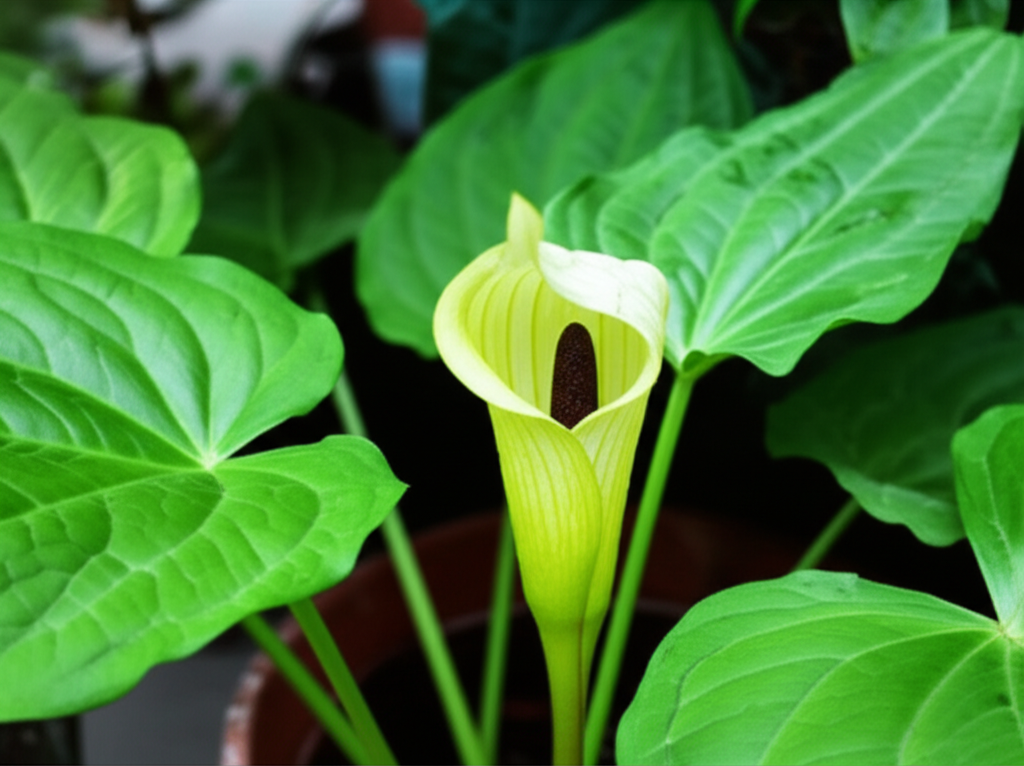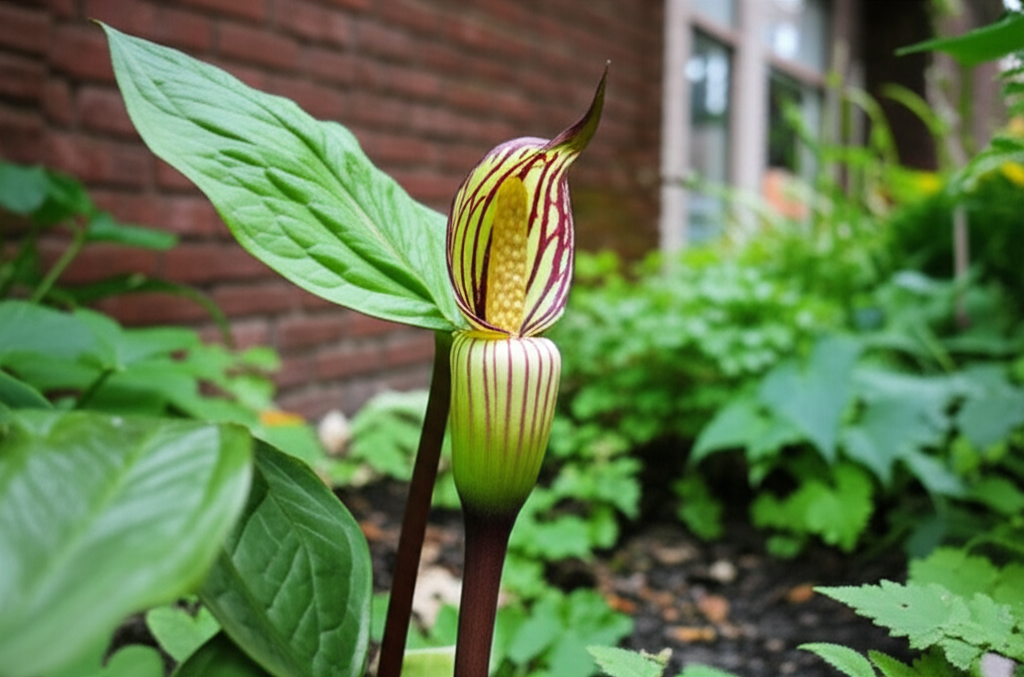Introduction: The Allure of the Jack-in-the-Pulpit
Urban gardening presents a unique set of challenges and opportunities. While space may be limited, the desire to cultivate beauty and biodiversity remains strong. For those seeking a touch of woodland magic in their compact urban oases, the Jack-in-the-Pulpit ( Arisaema triphyllum ) offers a captivating solution. This distinctive native perennial, with its hooded spathe and spadix resembling a preacher in a pulpit, brings an element of botanical intrigue and a touch of the wild to even the smallest city garden. Its unique beauty, coupled with its relatively low maintenance requirements once established, makes it an ideal choice for urban dwellers. This guide will provide a comprehensive, factual, and SEO-friendly approach to successfully growing Jack-in-the-Pulpit in your urban small garden.
Why Choose Jack-in-the-Pulpit for Your Urban Garden?
Beyond its striking appearance, the Jack-in-the-Pulpit boasts several qualities that make it a standout for urban cultivation:
- Unique Aesthetic: Its iconic flower structure is a guaranteed conversation starter and adds a focal point of botanical interest.
- Shade Tolerance: Many urban gardens struggle with ample sunlight due to surrounding buildings. Jack-in-the-Pulpit thrives in dappled shade and woodland conditions, making it perfect for shadier spots.
- Native Appeal: As a native plant, it supports local pollinators and wildlife, contributing to urban biodiversity.
- Low Maintenance: Once established, it is remarkably self-sufficient, requiring minimal care.
- Seasonal Interest: While its bloom is ephemeral, the attractive foliage persists, and in autumn, it develops vibrant red berries.
Understanding the Jack-in-the-Pulpit ( Arisaema triphyllum )
Before delving into cultivation, it’s essential to understand the plant’s basic needs and characteristics. The Jack-in-the-Pulpit is a herbaceous perennial that grows from a corm. It typically emerges in early spring, with its distinctive hooded flower appearing before or alongside its trifoliate leaves. The “Jack” is the spadix, and the “pulpit” is the spathe, which curves over the spadix. The plant produces a cluster of bright red berries in the fall, adding further ornamental value.
Key Considerations for Urban Jack-in-the-Pulpit Gardens

Urban gardening demands careful planning, especially when dealing with limited space and potentially altered microclimates. Understanding these factors is crucial for success.
Sunlight and Shade: Finding the Ideal Spot
Jack-in-the-Pulpit is a woodland plant, meaning it prefers partial to full shade. In an urban setting, this translates to:
- North-facing walls or fences: These areas naturally receive less direct sunlight.
- Beneath mature trees: If you have any trees, even smaller ornamental ones, their canopy can provide the dappled shade required.
- Areas shaded by buildings: Observe your garden throughout the day to identify spots that receive only a few hours of indirect sunlight.
- Avoidance of harsh afternoon sun: Direct, prolonged exposure to intense sunlight, especially in hotter urban environments, can scorch its leaves.
Soil: Mimicking its Natural Habitat
The Jack-in-the-Pulpit thrives in rich, moist, well-draining soil. In urban settings, this often means amending existing soil or utilizing containers.
- Compost and Organic Matter: Incorporate generous amounts of compost, leaf mold, or well-rotted manure to improve soil structure, fertility, and moisture retention.
- Slightly Acidic to Neutral pH: While adaptable, it prefers a soil pH between 6.0 and 7.0. A simple soil test kit can help you determine your garden’s pH.
- Drainage is Key: Even though it likes moisture, waterlogged soil can lead to corm rot. If your soil is heavy clay, consider adding grit or perlite to improve drainage, especially if planting in the ground.
Moisture: The Importance of Consistent Hydration
Maintaining consistent soil moisture is vital, particularly during the plant’s active growing season.
- Regular Watering: Water deeply when the top inch of soil begins to feel dry. This will be more frequent during hot, dry spells.
- Mulching: Apply a layer of organic mulch (wood chips, shredded bark, or compost) around the base of the plant. This helps retain soil moisture, suppress weeds, and regulate soil temperature.
- Container Gardening: Plants in containers tend to dry out faster, so monitor moisture levels closely and water as needed.
Container Gardening: A Solution for Limited Space
For many urban gardeners, containers are the answer to cultivating plants in limited spaces. Jack-in-the-Pulpit is well-suited for this.
- Pot Size: Choose pots that are at least 8-10 inches deep to accommodate the corm and root development.
- Drainage Holes: Ensure pots have adequate drainage holes to prevent waterlogging.
- Potting Mix: Use a high-quality potting mix that is rich in organic matter and drains well. You can amend standard potting soil with compost.
- Placement: Position containers in locations that receive the appropriate amount of shade.
Planting Your Jack-in-the-Pulpit
Successful planting sets the stage for a thriving Jack-in-the-Pulpit. Timing and technique are crucial.
When to Plant
The best time to plant Jack-in-the-Pulpit corms is in the fall, after the foliage has died back, or in early spring before new growth emerges.
How to Plant Corms
- Depth: Plant corms about 3-4 inches deep with the pointed end facing upwards.
- Spacing: If planting multiple corms, space them about 6-8 inches apart to allow for growth and air circulation.
- Orientation: While not critical, planting with the pointed end up generally facilitates better root establishment.
Starting from Seed (for the Patient Gardener)
Growing Jack-in-the-Pulpit from seed is a long-term project, as it can take several years for the plant to reach flowering size.
- Stratification: Seeds require a period of cold, moist stratification to germinate. Sow seeds in a pot of moist potting mix and refrigerate for 3-4 months.
- Sowing: After stratification, place the pot in a shaded, cool location and keep the soil consistently moist.
- Patience: Germination can be erratic and may take several months.
Care and Maintenance of Your Urban Jack-in-the-Pulpit
Once established, Jack-in-the-Pulpit is a relatively low-maintenance plant. However, a little attention can ensure its optimal health and beauty.
Watering and Fertilizing
- Watering: As mentioned, consistent moisture is key. Water deeply when the soil surface begins to dry. Reduce watering once the foliage dies back in late summer or early fall.
- Fertilizing: Jack-in-the-Pulpit does not require heavy fertilization. A top-dressing of compost or a light application of a balanced, slow-release organic fertilizer in early spring is usually sufficient. Over-fertilizing can lead to lush foliage but fewer flowers.
Pest and Disease Management
Jack-in-the-Pulpit is generally resistant to major pests and diseases. However, be aware of potential issues:
- Slugs and Snails: These can occasionally nibble on the leaves, especially when young. Handpicking or using organic slug baits can help.
- Root Rot: This is the most common problem and is usually caused by poor drainage. Ensure your soil is well-draining and avoid overwatering.
Dividing Established Plants
Over time, Jack-in-the-Pulpit plants can form clumps. Dividing them can help rejuvenate the plant and provide new plants for other areas of your garden or for sharing.
- Timing: The best time to divide is in the fall after the foliage has died back, or in early spring before new growth emerges.
- Process: Carefully dig up the clump. Gently separate the corms, ensuring each piece has at least one eye or bud. Replant the divisions immediately in well-prepared soil.
Key Facts and Comparison Table
To help visualize the essential elements of growing Jack-in-the-Pulpit, here’s a comparative table.
| Feature | Jack-in-the-Pulpit | Other Shade-Tolerant Perennials (e.g., Hostas) | Sun-Loving Annuals (e.g., Petunias) |
|---|---|---|---|
| Sunlight Needs | Partial to Full Shade | Partial to Full Shade | Full Sun |
| Water Needs | Consistent Moisture | Moderate to Consistent Moisture | Regular Watering (prone to drying out) |
| Soil Preference | Rich, Moist, Well-Draining | Rich, Well-Draining | Well-Draining (adaptable) |
| Maintenance | Low (once established) | Moderate | High (deadheading, regular watering) |
| Lifespan | Perennial | Perennial | Annual (dies after one season) |
| Unique Feature | Iconic hooded spathe and spadix, fall berries | Varied foliage textures and colors | Prolonged blooming, vibrant colors |
Steps to Success: Growing Jack-in-the-Pulpit in Small Urban Spaces
Here’s a step-by-step breakdown to guide you through the process.
| Step | Action | Tips for Urban Gardens |
|---|---|---|
| 1. Site Selection | Identify a location with dappled to full shade. | Observe sunlight patterns throughout the day. Consider the shade cast by buildings or mature trees. North-facing areas are ideal. |
| 2. Soil Preparation | Amend soil with compost and organic matter for richness and drainage. | If planting in the ground, incorporate ample compost into the existing soil. For containers, use a quality potting mix with added compost. |
| 3. Planting Corms | Plant corms 3-4 inches deep, pointed end up, in fall or early spring. | Ensure good drainage in containers or garden beds. Use larger pots for easier management. |
| 4. Watering | Maintain consistent soil moisture, especially during the growing season. | Mulch well to conserve moisture. Check container moisture levels frequently. |
| 5. Mulching | Apply a layer of organic mulch around the base. | Mulch helps keep roots cool and conserves water, crucial in urban environments that can heat up. |
| 6. Fertilizing (Optional) | Light feeding in spring with compost or balanced organic fertilizer. | Avoid over-fertilizing, which can reduce flowering. |
| 7. Observation | Monitor for pests (slugs/snails) and signs of distress. | Regular observation is key in a small space to catch any issues early. |
| 8. Division (After 3-5 years) | Divide overgrown clumps in fall or early spring. | Allows for propagation and rejuvenates the parent plant. |
Pros and Cons of Growing Jack-in-the-Pulpit in Urban Small Gardens
Every plant has its advantages and disadvantages, particularly in a specific environment.
| Pros | Cons |
|---|---|
| Adaptable to shade, common in urban settings. | Can be slow to establish and establish from seed. |
| Low maintenance once established, ideal for busy urbanites. | Requires consistent moisture, which can be challenging during dry spells without diligent watering or mulching. |
| Unique and captivating bloom structure. | Toxicity of the plant parts (all parts except cooked berries are toxic if ingested), requiring caution with pets and children. |
| Supports local wildlife and pollinators. | Foliage dies back in late summer, leaving a gap in the garden display. |
| Grows well in containers, making it perfect for balconies and patios. | Can be susceptible to slug and snail damage. |
| Provides seasonal interest with berries in the fall. | Not a plant for full sun enthusiasts. |
Beyond the Bloom: Seasonal Interest and Wildlife Benefits
The beauty of Jack-in-the-Pulpit extends beyond its striking floral display.
Autumn Berries
As the foliage begins to yellow and die back, the Jack-in-the-Pulpit produces a dense cluster of vibrant red berries. These berries are not only visually appealing but also provide a valuable food source for local birds.
Attracting Wildlife
While the bloom itself is not a primary nectar source for many insects, the plant can attract small native bees. More significantly, its presence in your garden contributes to the overall ecosystem, providing habitat and food for small creatures.
Conclusion: Bringing a Woodland Gem to Your Urban Retreat
Growing Jack-in-the-Pulpit in your urban small garden is a rewarding endeavor that brings a touch of wild enchantment to your concrete jungle. By understanding its needs for shade, moist yet well-draining soil, and consistent watering, you can cultivate this fascinating native perennial successfully. Whether planted in a shady border, tucked beneath a small urban tree, or thriving in a strategically placed container, the Jack-in-the-Pulpit promises to be a unique and captivating addition to your urban retreat, offering a glimpse into the wonders of the woodland ecosystem. Embrace the challenge, nurture this botanical marvel, and enjoy the distinctive beauty it brings to your limited urban space.


